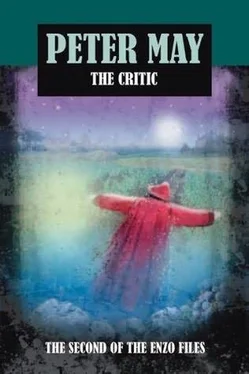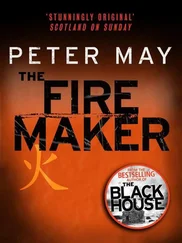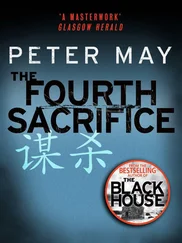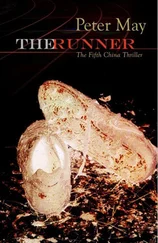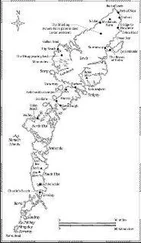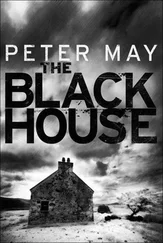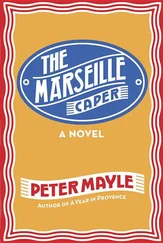Peter May - The Critic
Здесь есть возможность читать онлайн «Peter May - The Critic» весь текст электронной книги совершенно бесплатно (целиком полную версию без сокращений). В некоторых случаях можно слушать аудио, скачать через торрент в формате fb2 и присутствует краткое содержание. Жанр: Классический детектив, на английском языке. Описание произведения, (предисловие) а так же отзывы посетителей доступны на портале библиотеки ЛибКат.
- Название:The Critic
- Автор:
- Жанр:
- Год:неизвестен
- ISBN:нет данных
- Рейтинг книги:5 / 5. Голосов: 1
-
Избранное:Добавить в избранное
- Отзывы:
-
Ваша оценка:
- 100
- 1
- 2
- 3
- 4
- 5
The Critic: краткое содержание, описание и аннотация
Предлагаем к чтению аннотацию, описание, краткое содержание или предисловие (зависит от того, что написал сам автор книги «The Critic»). Если вы не нашли необходимую информацию о книге — напишите в комментариях, мы постараемся отыскать её.
The Critic — читать онлайн бесплатно полную книгу (весь текст) целиком
Ниже представлен текст книги, разбитый по страницам. Система сохранения места последней прочитанной страницы, позволяет с удобством читать онлайн бесплатно книгу «The Critic», без необходимости каждый раз заново искать на чём Вы остановились. Поставьте закладку, и сможете в любой момент перейти на страницу, на которой закончили чтение.
Интервал:
Закладка:
‘The body is that of a Caucasian adult male. Age is estimated around midthirties. The body is identified as Serge Coste by a tag tied about the right ankle. The body weighs seventy-three kilograms, measures one hundred and sixty-three centimetres in length, and has been refrigerated and is cool to the touch.’
Garapin reached up to turn off the overhead mike. ‘He’s some colour. How the hell do I describe that? He’s like…like rasperries soaked in eau de vie.’
Enzo thought it a very accurate description. Under the harsh lights of the autopsy room, the body did not seem as vividly coloured as it had in the woods the previous night. ‘You didn’t do the autopsy on Petty, then?’
The pathologist shook his head. ‘No, monsieur. But I’ve read the report.’ He turned his mike on again.
‘The skin is a pale, grey-pink all over. The palms and soles, while still pink-stained, are paler and wrinkled.’
He switched off the mike once more. ‘Just as if he’d remained in the bath too long. Only, in this case, a bath of red wine. What a way to go!’ He grinned.
Enzo noticed that Gendarme Roussel had gradually moved away from the table, and was about a metre back from it. He was a bad colour. Worse than the corpse in front of them.
Garapin moved meticulously over the surface of the body, noting contusions on the left shin, right knee, right forearm and an area of subgaleal hemorrhage on the left temple. With the help of an assistant, he manhandled the dead weight onto its front and examined the backs of the legs, the buttocks, the back, neck and head. He found more contusions on the left shoulder and another subgaleal hemorrhage on the head behind the right ear.
‘Are these post or antemortem injuries?’ Enzo said.
Garapin shook his head thoughtfully. ‘Almost impossible to tell. They appear to be postmortem. Bodies drowned in an ocean or a lake, for example, tend to have injuries, or damage, from rubbing on the bottom, or bashing against rocks after death.’
‘The same kind of injuries you might sustain falling or being pushed into a fermentation cuve in a chai?’
The pathologist looked doubtful. ‘There are a lot of contusions here. I’m not at all sure they would be consistent with falling into a cuve. And in any case, you would expect such injuries to be antemortem.’
‘You said you couldn’t tell whether they occurred before or after death.’
‘That’s right. See…’ He moved to the shoulder injury. ‘There’s no blood around here, which would lead you to think it happened postmortem. But the victim went missing, what, twelve months ago? If he’s been in wine all this time, which from the state of him seems likely, and these injuries were inflicted before death, then the liquid would have leeched the blood from around the skin wound, and it would have ended up looking pale and bloodless, like this, just as if it were postmortem.’ He turned away to the countertop behind him and leafed through a folder of photocopied pages. ‘Yes, you see what’s interesting is that Petty suffered very similar injuries, and the pathologist who carried out that autopsy wasn’t able to decide whether they were post or antemortem either.’ He turned back to the table and from his tool trolley lifted what looked to Enzo very much like a French chef’s knife. ‘Let’s cut him open, shall we?’
With Coste laid on his back, head propped by a half-moon block placed below the neck, Garapin made incisions from either shoulder to the chest, and then down towards the pubis.
‘The body is opened with a Y-shaped thoracoabdominal incision through the skin, and subcutaneous fat measuring 3.7 centimetres thick at the level of the umbilicus. The pleural, pericardial, and peritoneal cavities are smooth and glistening, with no abnormal accumulations of fluid or gas, and there are no adhesions. All organs are present and in their appropriate positions.’
The first autopsy Enzo attended had been carried out by students, under supervision, on a preserved corpse at the University of Glasgow’s faculty of medicine. The internal organs were subdued in colour, grey and pale, the blood dark and surprisingly unred. It had come as a shock to him, then, during his first post mortem on a fresh body, to discover how vividly coloured it was inside. The fat was a bright yellow-orange, the blood dark red, muscle the colour of steak, and the guts very nearly white.
Coste’s insides, however, bore a striking resemblance to that first, preserved corpse he’d seen in Glasgow. Except that the muted grey of the organs had a pink blush to them. And the overwhelming smell that rose from the open cadaver was that of stale alcohol, like a pub the morning after a drunken party.
Wielding a pair of what looked very much like garden shears, Garapin flexed thick muscles in his forearms to cut easily through the ribs, one a time. Each one gave with a sickening crack. He took a knife to separate the breast plate from the diaphragm, and the fatty tissue sac that held the heart, before lifting the cage aside to get full access to the organs.
Holding the heart in one hand, he snipped open the pericardial sac looking for blood or excess fluid, but found none. Then he lifted the heart out for examination.
‘The endocardial surface has a usual appearance and there are no mural thrombi. The valves are thin and pliable and are neither stenotic nor dilated. The coronary arteries have a usual distribution and show minimal atherosclerotic disease. There are no thrombi. The aorta is patent, without injury, and shows minimal atherosclerosis.’
‘Meaning what?’ Enzo said.
‘That he didn’t die of a heart attack.’
The pathologist moved on to the respiratory system, removing and weighing one lung at a time. They were grey-pink and spongy. He shook his head. ‘Heavy. Waterlogged. Or should I say, winelogged. He wasn’t getting any oxygen through these.’
‘You’re saying he drowned?’
‘I’m not saying anything, except that there was wine in his lungs. Whether he breathed it in, or it seeped in over time, is impossible to tell.’
He sectioned them in turn, looking for giveaway particles, pieces of grape skin, fragments of seed, but found none, then turned to the gastrointestinal system and the stomach.
‘The rugal pattern of the stomach is normal and there are no ulcers. It contains 300 millilitres of dark red fluid. An ethanol odour is noted.’
The pathologist flicked off his mike. ‘No partially digested food material in there, just wine. So it had been some time before he’d eaten.’ He chuckled. ‘Should have known better than to drink on an empty stomach.’
Enzo was aware of Roussel’s breathing becoming shallower behind him. He said, ‘Gendarme Roussel was at school with the victim, Doctor Garapin.’
The pathologist glanced at the policeman. ‘Sorry.’ And he turned back to the job at hand, head down to examine the intestines. He cut the endless, looping tube from the fat which bound it, and slit it open from end to end releasing a thick, pungent odour that almost made Enzo gag.
Next, he removed the pancreas, liver, kidneys, spleen, and thyroid, and weighed and sectioned them on the countertop, describing each in turn, finding nothing unusual.
While he was breadloafing the organs, his assistant incised the scalp from ear to ear behind the head, and rolled the scalp down over the face, like peeling off a mask. He warned Enzo and Roussel to stand back as he took a circular saw around the top of the skull, the noise of it filling the room, along with the smoky, sweet smell of burning bone.
When he finished, and pulled the skull cap away, it was with a sucking noise and a loud ‘pop’ as it disengaged from the brain. Then he pulled the brain itself gently back towards him, beginning at the forehead, transecting it from the cranial nerves and spinal cord, so that finally it plopped out into his cupped hands.
Читать дальшеИнтервал:
Закладка:
Похожие книги на «The Critic»
Представляем Вашему вниманию похожие книги на «The Critic» списком для выбора. Мы отобрали схожую по названию и смыслу литературу в надежде предоставить читателям больше вариантов отыскать новые, интересные, ещё непрочитанные произведения.
Обсуждение, отзывы о книге «The Critic» и просто собственные мнения читателей. Оставьте ваши комментарии, напишите, что Вы думаете о произведении, его смысле или главных героях. Укажите что конкретно понравилось, а что нет, и почему Вы так считаете.
